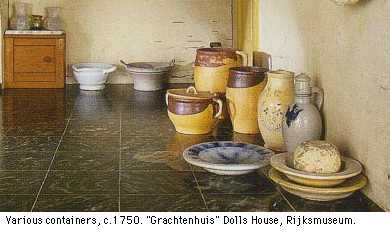

 Function
of this room: Cool storage space. Neither the
room nor its objects were mentioned in the inventory. We know
that the basement (E) was present because of the room called "room on
top of the basement ('Op de keldercamer') (B). The basement is part
of the lower house structure ('onderhuis'). The basement could be
reached from the street side and from the cooking kitchen kookkeuken
which was was a few steps up (D).
Function
of this room: Cool storage space. Neither the
room nor its objects were mentioned in the inventory. We know
that the basement (E) was present because of the room called "room on
top of the basement ('Op de keldercamer') (B). The basement is part
of the lower house structure ('onderhuis'). The basement could be
reached from the street side and from the cooking kitchen kookkeuken
which was was a few steps up (D).
Could the basement have been rented out? See similar situations in the book on Dutch Interiors by Fock.
See the original documents from the Delft Archives. Goods owned by Catharina Bolnes, page 1, page 2, page 3, page 4, page 5, page 6, page 7. Goods jointly owned by Catharina Bolnes and Maria Thins, page 1, page 2, page 3, page 4, page 5, page 6.
Noot : This room is indicated on the Zantkuijl reconstruction (2001), but not listed in the 1676 inventory. The Vermeer-inventory was listed by the assistant of Delft notary public J. van Veen on February 29, 1676, in the Thins/Vermeer home located on Oude Langendijk on the corner of Molenpoort. The painter Johannes Vermeer had died there at the end of December 1675. His widow Catherina and their eleven children still lived there with their mother Maria Thins.
The transcription of the 1676 inventory, now in the Delft archives, is based upon its first full publication by A.J.J.M. van Peer, "Drie collecties...", Oud Holland,1957, pp. 98-103.
Renting out basements, see: C. Willemijn Fock, Titus M. Eliëns, Eloy F. Koldeweij, Jet Pijzel Dommisse, Het Nederlandse interieur in beeld 1600 - 1900, Waanders, Zwolle, 2001, p. 27.

This page forms part of a large encyclopedic site on Vermeer and Delft. Research by Drs. Kees Kaldenbach (email). A full presentation is on view at johannesvermeer.info.
Launched December, 2002; Last update March 1, 2017.
Back to the Welcome page: click Welcome.